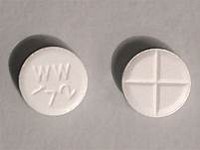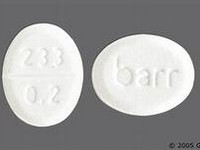Captopril

Captopril
CLINICAL USE
Angiotensin-converting enzyme inhibitor:
Hypertension Heart failure Post myocardial infarction Diabetic nephropathy DOSE IN NORMAL RENAL FUNCTION
6.25–50 mg 2–3 times dailyDiabetic nephropathy: 75–100 mg daily in divided doses PHARMACOKINETICS
Molecular weight :217.3 %Protein binding :25–30 %Excreted unchanged in urine : 40–50 Volume of distribution (L/kg) :2half-life – normal/ESRD (hrs) :2–3/21–32 DOSE IN RENAL IMPAIRMENT
GFR (mL/MIN)
20 to 50 : Start low – adjust according to response 10 to 20 : Start low – adjust according to response <10 : Start low – adjust according to response DOSE IN PATIENTS UNDERGOING RENAL REPLACEMENT THERAPIES
CAPD :Not dialysed. Dose as in GFR <10 mL/min HD :Dialysed. Dose as in GFR <10 : mL/minHDF/high flux :Dialysed. Dose as in GFR <10 : mL/minCAV/VVHD :Dialysed. Dose as in GFR=10–20 mL/min IMPORTANT DRUG INTERACTIONS
Potentially hazardous interactions with other drugsAnaesthetics: enhanced hypotensive effect cinAnalgesics: antagonism of hypotensive effect and increased risk of renal impairment with NSAIDs; hyperkalaemia with ketorolac and other NSAIDsCiclosporin: increased risk of hyperkalaemia and nephrotoxicityDiuretics: enhanced hypotensive effect; hyperkalaemia with potassium-sparing diureticsEpoetin: increased risk of hyperkalaemia; antagonism of hypotensive effectLithium: reduced excretion, possibility of enhanced lithium toxicityPotassium salts: increased risk of hyperkalaemia. Tacrolimus: increased risk of hyperkalaemia and nephrotoxicity ADMINISTRATION
Reconstition
– Route
Oral Rate of Administration
– Comments
Tablets may be dispersed in water OTHER INFORMATION
Adverse reactions, especially hyperkalaemia, are more common in patients with renal impairmentEffective sub-lingually in emergencies As renal function declines a hepatic elimination route for captopril becomes increasingly more significantRenal failure has been reported in association with ACE inhibitors in patients with renal artery stenosis, post renal transplant, or in those with congestive heart failureA high incidence of anaphylactoid reactions has been reported in patients dialysed with high-flux polyacrylonitrile membranes and treated concomitantly with an ACE inhibitor – this combination should therefore be avoidedClose monitoring of renal function during therapy is necessary in those with renal insufficiency.
See how to identify renal failure stages according to GFR calculation
See how to diagnose irreversible renal disease
Home









